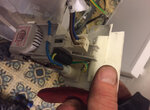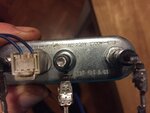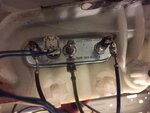HenryBenry
Newbie level 5

Hi all...first post here. Can any electronics genius give a total amateur some advice on wiring up an old washing machine pump? It pumped out the waste water. I think I could work from a circuit diagram if I could find one.
I have got it to run since pulling it out of the old washing machine, but want to check I am doing it properly by fusing it and so on. It is 240v but wires to it look very skinny. I used the original plug from the machine which has some sort of copper coil on the back and thin wires connection, and that got it running.
Writing on the pump say this.
1 KEBS 116/065A CL. 115 093/ 17 19:54 220-240v 50hz 0.19A 25W 160029518.02
Any help would be much appreciated.
I have got it to run since pulling it out of the old washing machine, but want to check I am doing it properly by fusing it and so on. It is 240v but wires to it look very skinny. I used the original plug from the machine which has some sort of copper coil on the back and thin wires connection, and that got it running.
Writing on the pump say this.
1 KEBS 116/065A CL. 115 093/ 17 19:54 220-240v 50hz 0.19A 25W 160029518.02
Any help would be much appreciated.









